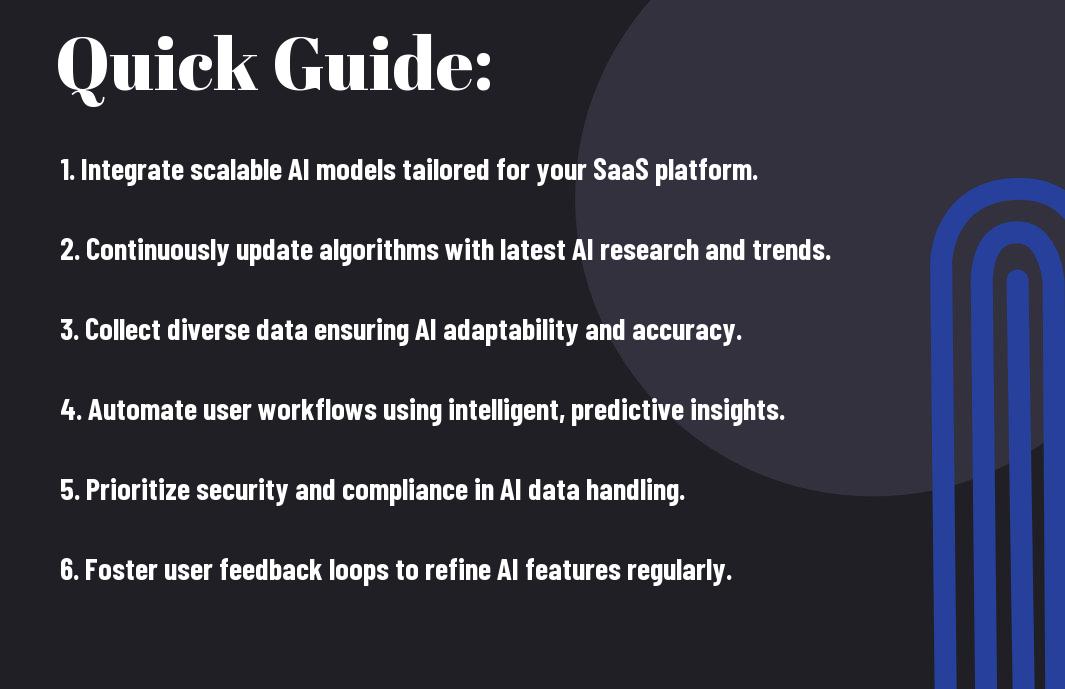SaaS solutions must continually evolve to meet the ever-growing demands of users, and incorporating advanced AI capabilities is important for staying competitive. By integrating AI, you can enhance user experience, streamline operations, and improve decision-making processes. This guide will provide you with actionable insights on how to leverage AI effectively, ensuring your offering remains relevant and valuable in the future. Embrace these strategies to not only meet current needs but also anticipate future trends in the SaaS landscape.
Key Takeaways:
- Integrate AI-driven analytics to enhance the personalization of user experiences and improve customer retention.
- Focus on developing scalable AI solutions that can adapt to evolving market needs and customer feedback.
- Emphasize security and data privacy in AI implementation to build trust and comply with regulatory standards.
The Competitive Edge: Harnessing AI for Differentiation
Establishing a competitive edge in the SaaS landscape hinges on your ability to leverage AI capabilities effectively. Organizations that utilize advanced AI find themselves in prime positions to innovate their service offerings and outpace competitors. As highlighted in this insightful article on AI-Powered SaaS: Redefining the Future of Enterprise, AI is not just a tool—it’s a transformative force that can reshape how you engage with customers and optimize processes.
Identifying Unique Value Propositions with AI
Employing AI allows you to identify unique value propositions that resonate with your target market. By analyzing customer data, behaviors, and preferences, you can pinpoint what differentiates your offering. These insights enable you to highlight specific features or services that address the unique pain points of your customers, making your SaaS solution more appealing and compelling.
Customizing User Experience through Intelligent Insights
Utilizing AI for customizing user experience transforms how users interact with your software. Advanced algorithms analyze vast amounts of data in real-time, delivering personalized recommendations that enhance user satisfaction. By tailoring experiences based on individual needs, you not only foster engagement but also drive retention, as users consistently receive the most relevant content and features.
By integrating intelligent insights into your user experience strategy, your SaaS offering can evolve based on user interactions, preferences, and feedback. Consider Chatbots or AI-driven dashboards that present users with information tailored to their previous behavior or queries. Companies like Spotify have excelled at personalizing playlists and recommendations, leading to increased user engagement and loyalty. The more you understand your users through data, the better you can tailor their journey, creating a platform that’s not just functional but highly engaging, ensuring customers come back time and again.

Building a Scalable Framework: Integrating AI into SaaS Architecture
Integrating advanced AI capabilities into your SaaS architecture means developing a scalable framework that can accommodate evolving technologies. Focusing on modularity and microservices will allow you to easily integrate new AI functionalities without disrupting existing services. By leveraging containerization and orchestration tools, you can ensure smooth deployment and management of your AI models as they mature over time, ultimately enhancing your service offerings.
Choosing the Right AI Technologies and Tools
Selecting the appropriate AI technologies and tools plays a pivotal role in your framework’s success. You’ll want to assess existing platforms that align with your objectives, like TensorFlow for machine learning or spaCy for natural language processing. Balancing performance and scalability is imperative, so consider tools that facilitate seamless integration into your architecture while maintaining low latency for your end-users.
System Design for Flexible AI Model Deployment
A flexible design allows you to deploy AI models quickly as business needs shift. Your architecture should support various deployment strategies, including on-premise, cloud, or hybrid approaches. This adaptability enables you to choose the most efficient environment based on computational demands and latency considerations.
When designing for flexible deployment, you must consider the use of API-driven architectures that facilitate interactions between your application and AI models. A microservices approach allows individual AI components to be updated or replaced without affecting the entire system. Tools like Docker and Kubernetes also enhance deployment options, ensuring that your architecture can flexibly scale as your SaaS offering grows. In addition, utilizing CI/CD pipelines can automate the integration and delivery process, enabling you to deploy updates and new models rapidly, keeping your offerings fresh and responsive to market demands.
Data-Driven Decision Making: Elevating Business Intelligence with AI
Data-driven decision making harnesses the power of AI to enhance business intelligence, allowing you to gain deeper insights into customer behavior, operational efficiency, and market trends. By leveraging machine learning algorithms, you can identify patterns within vast datasets, driving more informed decisions that ultimately lead to optimized performance and growth. As a result, businesses leverage AI-enhanced analytics for predictive forecasting and tailored strategies, ensuring they stay ahead of the competition.
Leveraging Predictive Analytics for Strategic Insights
Predictive analytics empowers your SaaS offering to anticipate future trends and behaviors by analyzing historical data. Through algorithms that identify correlations and prepare forecasts, you can strategically adapt your services to meet evolving customer needs. This capability not only improves customer retention but also uncovers potential new revenue streams, enabling you to fine-tune your product features and marketing efforts effectively.
Real-Time Data Processing for Adaptive SaaS Solutions
Real-time data processing enhances your SaaS solutions by allowing immediate adjustments based on current user interactions and market conditions. By integrating AI-driven analytics, you can monitor engagement, identify issues as they arise, and make decisions that reflect the latest data trends. This adaptability ensures that your services remain relevant and responsive, ultimately leading to improved customer satisfaction and loyalty.
Utilizing real-time data processing enables you to transform your SaaS offerings into dynamic solutions that can swiftly respond to changing circumstances. For instance, if a sudden spike in user activity suggests an emerging trend, AI algorithms can immediately analyze this data and suggest enhancements to your platform or alert you to necessary adjustments. Such real-time insights not only enhance user experiences but also optimize operational efficiencies, helping you to stay agile and competitive in a fast-paced market. Platforms equipped with this technology can reduce response times significantly, providing customers with timely support and innovative features that set your service apart from others.
Ensuring Security and Compliance: AI’s Role in Safeguarding SaaS Offerings
Utilizing AI in your SaaS platform not only enhances performance but also plays a vital role in strengthening security and ensuring compliance with various regulations. AI tools can automatically identify vulnerabilities, monitor user activities, and detect potential threats in real-time. By leveraging machine learning algorithms, your SaaS offering can proactively authenticate users and protect sensitive data, fostering trust with your customers and protecting your business’s reputation.
Navigating Regulatory Landscapes with AI Tools
AI tools can streamline compliance processes by automating the monitoring and reporting of regulatory requirements. They allow you to analyze vast amounts of data quickly, ensuring your SaaS platform adheres to standards such as GDPR, HIPAA, and others. With AI-driven insights, you can identify non-compliance risks before they escalate, enabling your business to take timely corrective actions.
Implementing AI-Driven Security Protocols
Integrating AI-driven security protocols into your SaaS platform enhances your ability to protect data and safeguard user privacy. These protocols include advanced threat detection systems that utilize predictive analytics to foresee potential security breaches. By continually analyzing patterns in user behavior, your AI systems can identify anomalies and trigger alarms, thereby minimizing the risk of data breaches.
AI-driven security protocols are not just reactive but also proactive in nature. For instance, incorporating AI can automate your incident response processes, allowing for quicker containment of threats and reducing downtime. You can set contextual thresholds that help identify when an account may be compromised, deploying immediate responses such as user alerts or temporary account locks. This flexibility lets you adapt to ever-evolving threats while maintaining operational efficiency, ensuring that your SaaS offering remains resilient against cyber risks and fully compliant with industry regulations.

Cultivating a Culture of Innovation: Fostering AI Adoption in Teams
Fostering a culture of innovation isn’t just about new ideas; it’s about embracing the transformative power of AI across your teams. By encouraging collaboration and experimentation, you create an environment where employees feel empowered to explore AI applications that enhance your SaaS offerings. Celebrate successes, learn from failures, and integrate AI thinking into everyday processes to embed innovation in your organization’s DNA.
Training and Upskilling Employees for AI Proficiency
Investing in targeted training programs equips your employees with the necessary AI skills to maximize the capabilities of your SaaS. Provide access to workshops, online courses, and certifications that cover imperative topics like machine learning, data analytics, and AI ethics. As your team becomes proficient, their confidence in utilizing AI effectively will lead to innovative solutions that drive business success.
Creating an Agile Environment for Continuous Improvement
Agility enables your team to swiftly respond to changes and integrate new AI technologies as they emerge. Establishing a flexible framework fosters rapid iteration, allowing teams to test and refine AI solutions in real-time. Encourage daily stand-ups and regular feedback loops to keep momentum and collaboration high. Implementing tools like Kanban or Scrum can create a structure that supports constant learning and adaptation to stay ahead of the competition.
Agile methodologies promote an experimental mindset, motivating teams to rapidly conduct A/B tests on AI features and analyze feedback without the fear of failure. For instance, a SaaS company might release a beta version of an AI-driven analytics tool to a select group of users. Gathering insights through user interactions allows quick adjustments, significantly improving the final product. This iterative process not only enhances the software but also cultivates a dynamic team environment aimed at innovation and excellence.
Conclusion
Considering all points, you should integrate advanced AI capabilities into your SaaS offering to not only enhance user experience but also ensure your service remains relevant in a rapidly evolving market. By leveraging AI for personalization, automation, and data analytics, you position your product to meet customer needs more effectively. Stay informed about emerging technologies and adapt your strategy accordingly. With these steps, you can secure a competitive edge and foster lasting customer loyalty in the dynamic SaaS landscape.
FAQ
Q: What are the benefits of incorporating advanced AI capabilities into my SaaS offering?
A: Integrating advanced AI capabilities into your SaaS offering can lead to numerous benefits. Firstly, it enhances user experience by providing personalized services and recommendations, which can result in higher customer satisfaction. Secondly, AI can automate routine tasks, improving efficiency and allowing your team to focus on more strategic initiatives. Additionally, advanced analytics powered by AI can uncover insights from user data, enabling you to make informed decisions and adapt to market trends quickly. This not only helps in retaining existing customers but can also attract new ones with innovative features.
Q: How can I identify the right AI technologies to implement in my SaaS solution?
A: To identify the appropriate AI technologies for your SaaS solution, start by evaluating the specific needs of your target audience. Conducting user research and gathering feedback can inform which areas require enhancement. Explore various AI technologies such as natural language processing, machine learning, and predictive analytics. Assess your existing infrastructure to determine compatibility and scalability. It may also be advantageous to collaborate with AI specialists or consultants who can provide insights into the best practices and tools available in the market, ensuring that the technology you choose aligns with your overall business strategy.
Q: What steps should I take to ensure the security of AI-driven features in my SaaS application?
A: Ensuring the security of AI-driven features in your SaaS application involves multiple strategies. First, implement robust data protection measures, including encryption and secure access controls, to safeguard sensitive information processed by AI algorithms. Second, ensure compliance with relevant regulations, such as GDPR, to protect user privacy and data usage rights. Additionally, continuously monitor the performance and behavior of AI models to detect anomalies or potential vulnerabilities. Regularly updating your security protocols and conducting audits can also help in maintaining a strong security posture. Educating your team about best practices in AI security is equally important in creating a culture of security awareness within your organization.







